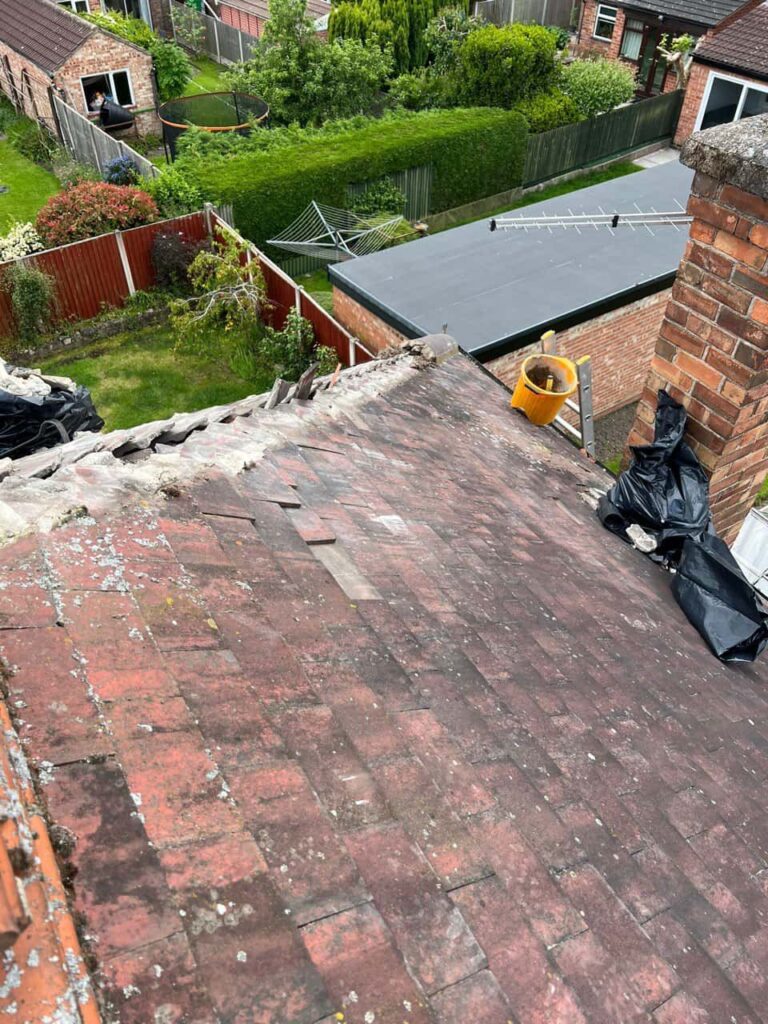Roofing felt plays a vital role in protecting your home from the elements, acting as a secondary barrier beneath your tiles or slates. Over time, however, this material can begin to degrade—especially in older roofs where traditional bitumen-based felt was used. At Oadby Roofing Repairs, we’ve seen many cases across Oadby, Leicestershire where ignoring peeling or damaged felt has led to significant and costly problems.
If you’ve noticed signs that your roof felt is peeling, cracked, or lifting, it’s essential to act quickly. Here’s why replacing it now can save you from bigger issues down the line.
What Causes Felt to Peel Away?
Roofing felt is exposed to a range of harsh conditions year-round. Over time, several factors can contribute to its deterioration:
- UV exposure: Sunlight gradually breaks down the surface of old felt, causing it to become brittle and crack.
- Moisture and freeze-thaw cycles: Repeated exposure to water and temperature fluctuations leads to shrinkage, tearing, and lifting at the edges.
- Poor ventilation: A lack of airflow in the loft can increase humidity levels, promoting mould growth and weakening the felt from beneath.
- Ageing materials: Older roofs may still use traditional felt, which simply doesn’t last as long as today’s breathable, reinforced membranes.
When felt begins to peel or lift, it creates pathways for water to enter—making your home vulnerable to much more serious damage.
The Hidden Risks of Ignoring Peeling Felt
1. Water Ingress and Damp
The biggest threat from failing roof felt is water. Once water penetrates beneath your tiles and enters the roofing structure, it can cause rot in timbers, mould in insulation, and staining on ceilings. What starts as a small patch of peeling felt can quickly escalate into structural problems.
2. Loss of Insulation Performance
Damp insulation loses its effectiveness, leading to heat loss and higher energy bills. Wet insulation can also become a breeding ground for bacteria and fungi, creating health concerns within the home.
3. Accelerated Tile Failure
Peeling felt often indicates that water is reaching parts of the roof that should remain dry. This constant exposure can degrade tile fixings or battens, causing tiles to shift or crack more easily in bad weather.
4. Higher Repair Costs
Delaying a felt replacement often leads to more extensive repairs being needed—such as timber replacement, internal plastering, or even a full roof strip and reinstallation. Replacing the felt early is a far more cost-effective approach.
Modern Alternatives Offer Better Protection
The good news is that today’s roofing technology provides more durable solutions. Modern underlays are breathable, tear-resistant, and designed to last for decades. Replacing old felt with a high-quality membrane improves:
- Ventilation and airflow in the loft
- Protection from wind-driven rain
- Overall roof performance and energy efficiency
At Oadby Roofing Repairs, we install high-grade breathable membranes that are tailored to suit the specific needs of homes in Oadby, Leicestershire—whether as part of a roof repair or full roof replacement.
Signs You Need a Felt Replacement
Look out for these warning signs:
- Visible felt peeling or hanging at eaves or edges
- Persistent leaks or damp patches in the loft
- Mould growth on roof timbers or insulation
- Missing or dislodged tiles, often caused by damaged underlay
If in doubt, our team can carry out a full roof inspection to assess the condition of your felt and advise on the best course of action.
Conclusion
Peeling roof felt is not just a cosmetic issue—it’s a warning sign that your home’s first line of defence is failing. Replacing it before damage spreads can save you from costly repairs and ensure your roof continues to protect your property effectively.
If you’ve noticed signs of wear or are concerned about the condition of your roof, contact Oadby Roofing Repairs today. We provide expert felt replacements and roofing services across Oadby, Leicestershire, helping homeowners keep their properties safe, dry, and energy efficient.
Call us on: 0116 216 5695
Click here to find out more about Oadby Roofing Repairs
Click here to complete our contact form and see how we can help you with your roofing needs.

